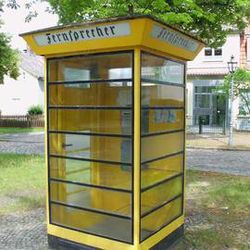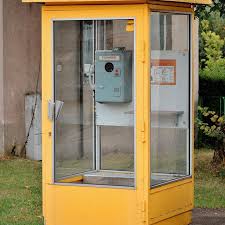German Telephone tokens
Telephone in Germany started modestly in 1877 with a 2 kilometer experimental line, set up by the postmaster-general's office. Siemens & Halske were charged with the construction of a network. From November 1877, Siemens & Halske could produce 200 telephones a day. In 1879, Deutsche Reichspost obtained a de facto monopoly by legal interpretation of the state monopoly on telegraphy. From 1881, public and private local networks were opened in the big cities, starting with Berlin, Breslau, Frankfurt am Main, Hamburg, Cologne, Mannheim and Munich. Local networks were connected from 1883, making long distance calls possible. In 1900, Berlin inaugurated the first German international telephone connection, with Paris. In 1908, Hildesheim was the first town where telephone subscribers could dial local numbers, rather than going through an operator.
In the severe winter of 1909, a storm toppled over a row of telephone cable masts carrying the telephone cable between Berlin and Magdeburg. It took months to repair the damage. As a consequence, from 1912, new cables were laid underground only. The local networks developed steadily, so that there was a need for telephone booths, which in turn led to local as well as national tokens.
In the 1920s, multiple line cables and, from 1923, long distance automatic telephone exchanges increased the capacity of the national network rapidly. In 1928, the German railways obtained the right to develop their own national network (Bahn Selbstanschluss Anlage, BASA) that functioned as a nationwide internal network for railway employees.
The second world war brought widespread destruction to the telephone network. The Russian occupation zone became a separate German state, the German Democratic Republic (East Germany). These developments caused a slowdown in automatisation and modernisation of the network.
In the Federal Republic, Deutsche Post replaced Deutsche Reichspost in 1947, only to become Deutsche Bundespost in 1950 (booth at right) to differentiate it from Deutsche Post in East Germany (booth at left); telephone was covered by the Fernmelde Technische Zentralamt (FTZ) agency. In 1955, the first automatic international connection was established between Lörrach and Basel. In fact, this was more like a local connection. The last manual exchange, in Uetze, was shut down only in 1966. From 1975, rotary dials were replaced by buttons. From 1979, digitalisation started.
The first postal reform, in 1989 split up Deutsche Bundespost in independent units, including Deutsche Bundespost Telekom, a state enterprise. Deutsche Post, from East Germany was folded into this agency in 1990. In January 1995, the second postal reform created Deutsche Telekom AG, a commercial company owned by the state. Privatisation started in 1995 with sales of shares. In 1996, the telephone monopoly of Deutsche Telekom AG was withdrawn. In 2010, a subsidiary, Telekom Deutschland was set up to service small customers.
German telephone tokens come in a number of classes:
- Germany as unitary state (Deutsches Reich)
- Federal Republic of Germany (Bundesrepublik Deutschland)
- Fernmeldetechnisches Zentralamt
- Regional and local issues
- East Germany (Deutsche Demokratische Republik)



